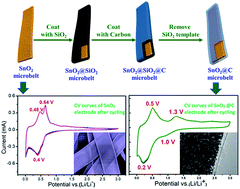Microbelt–void–microbelt-structured SnO2@C as an advanced electrode with outstanding rate capability and high reversibility†
Abstract
Nanoscale SnO2 materials are highly active in charge/discharge processes, but suffer from both poor interconnectivity and re-agglomeration. In this paper, we report the development of a novel microbelt–void–microbelt SnO2@C structure, in which the inner SnO2 nanoparticles-derived microbelt possessed the advantage of high reactivity, the abundant void space effectively buffered the volume change, and the outer microscale carbon shell supplied a fast convenient electronic conduction path and shortened the ion-diffusion distance. Resultant microbelt–void–microbelt-structured SnO2@C-based half cells delivered a high capacity of 1227 mA h g−1 after 300 cycles at 300 mA g−1, and a superior rate performance of 509 mA h g−1 at a high current density of 10 A g−1. The full-cell measurements coupling with LiCoO2 showed a high capacity of 588 mA h g−1 after 100 cycles. The superior electrochemical performance may be attributed to the unique microbelt–void–microbelt structure, which enables highly reversible alloying and allows the conversion reaction of SnO2 to Sn in the long-term cyclic processes.



 Please wait while we load your content...
Please wait while we load your content...